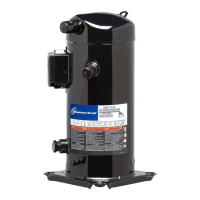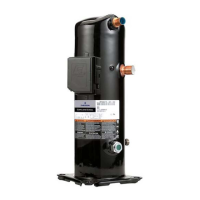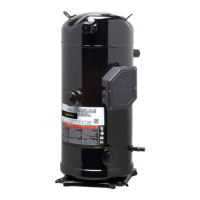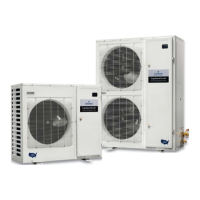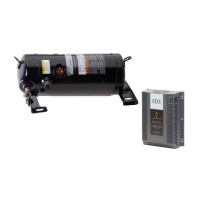C6.2.7/0302-0903/E 4
The application envelopes for each refrigerant are shown in section 31 and Copeland Selection software.
4 Lubrication
The oil level should be maintained at mid-point of the sight glass. If an oil regulator is being used the level should be
set within the top half of the sight glass.
An internal positive displaced oil pump, draws oil from the compressor base via a dip tube for lubrication of the
bearings.
The compressor is supplied with an initial oil charge. The standard oil charge is a Polyolester (POE) lubricant ICI
Emkarate RL 32 CF (32 cSt). In the field, the oil level could be topped up with either ICI Emkarate RL 32 CF or Mobil
EAL Arctic 22 CC. The values can be taken from Copeland’s brochure.
They must be operated with these specific oils only. Under no circumstances are polyolester oils to be mixed with
mineral oil and/or alkyl benzene when used with chlorine-free refrigerants.
Ester oil behaves extremely hygroscopically (see figure 1), and this influences the chemical stability of the oil.
The number of start/stop cycles should be limited to 10 per hour. A high cycling rate will pump oil into the system and
may lead to lubrication failure. Oil leaves the compressor at start up regardless of the low oil carry over of the Scroll.
Short running time is insufficient to return the oil to the compressor and possibly results in a lack of lubricant.
Figure 1: Absorption of moisture in ester oil in comparison to mineral oil (ppm) by weight at 25°C and 50%
relative humidity. h = hours
It must be considered that the entire system will be coated with oil to some extent. Oil viscosity changes with
temperature. System gas velocity changes depending on temperature and load. In low load conditions gas velocity
may not be high enough to return oil to the compressor. System piping should be designed to return oil under all
operating conditions, including part loads.
The system should be evacuated down to 0.3 mbar/ 0.22 Torr or lower. If there is uncertainty, as to the moisture
content in the system, an oil sample should be taken from various points and tested for moisture. The residual
moisture in the installation should be brought below 50 PPM by good evacuation practice (refer to section 25 System
Evacuation and Charging Procedure) and the use of a suitable filter drier (solid core XH9 or higher is recommended).
Sight glass/moisture indicators currently available can be used with the HFC refrigerants and lubricants; however, the
moisture indicator will indicate the moisture content of the refrigerant. The actual moisture level of POE could be
higher than the sight glass specifies. This is a result of the high hygroscopicity of the POE oil.
5 Liquid Injection
For low temperature applications ZFH models, liquid injection is required to keep discharge gas temperatures within
allowable limits.
The compressor is supplied with a 13/16" UNF diameter injection stub to accept a DTC (Discharge temperature
control) valve for liquid injection. The same DTC valve can be used for all compressors and approved refrigerants.
Inside the compressor, injection takes place into two distinct pockets of the scroll involute without influencing the
suction process. Injection increases the mass flow through the system slightly.
The ZFH compressor (BOM 555 and 556) incorporates a thermal well in the discharge cap, to accommodate the DTC
bulb, combined with a valve cap.

